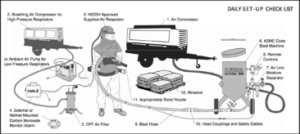Cleaning and surface preparation is a process that is performed prior to applying a paint system for coating metal elements or to applying a concrete coating system.
The surface preparation process before the coat system application is highly important in obtaining the final result of the overall system. The surface preparation is intended for cleaning and clearing old coats and rust, roughening the base for mechanical adhesion of the foundation (primer) in order to create optimal adhesion of the cost to the element.
Abrasive Cleaning Using Abrasives:
The tasks of the surface preparation stage include surface cleaning and roughening of the surface in accordance with European and US standards (ISO-8501, SSPC standards or corresponding NACE standards). These include removal of the old coat, removal of rust and scales from metal elements and rebar cages and removal of welding slag; in concrete, opening little holes and preparing a stable, homogeneous surface ready to be coated.
Aggregate shape is significant in the surface preparation process. Aggregates may be classified into two groups: “grit” has serrated edges while “shot” are rounded. The different types of aggregate and their disintegration when blasted on the surface create different roughness profiles in accordance with the coat specification. In some cases, an abbreviated process, “sandwashing”, may be implemented. This is lower pressure blasting of aggregates with the sprayer nozzle close to the surface, which creates a gentler roughening of the surface (shine reduction).
Abrasive cleaning requires an open cleaning system,which includes:
A portable dry air compressor, a sand tank (for the abrasive material), an air compressor to supply clean air to the operator’s mask at application, suitable compressed air hoses, a fuel tank, appropriate abrasives and a personal protective kit.
Basic Scheme for an Open Cleaning System
Mechanical cleaning
Where abrasive blasting is impossible or prohibited, manual cleaning is performed using electrical or pneumatic (air pressure driven) tools, and sometimes completely manual cleaning without mechanical tools. The mechanical cleaning process and its outcomes are equivalent to abrasive blasting and and is also subject to a series of European and US standards (as mentioned in the previous section). This process includes scraping and rubbing the surface until a clean surface, free of rust and scales, is obtained, roughening metals and steel and removing the old coating. A wide range of specific tools and accessories are available for this step, including rotating steel brushes, wide chisels for removal of blocks of rust, sandpapers and grinding discs, chipping devices (pneumatic pin guns) and standard and eccentric grinding devices designed for this purpose.
High-Pressure and Ultra-High Pressure Water Wash
Pressurized water washes are common in surface preparation before applying the coat and paint systems. Pressure selection and the type of wash are done according to the technical specification and project requirements. A basic wash at up to 350 bar pressure is primarily intended for dust removal and residual contaminants such as loose paint, rust, and plaster particles on the base.
A wash at a water pressure of up to 1,000 bar is considered “high pressure wash” and enables complete removal and cleaning chunks of scales and rust adhered to the surface and in the case of concrete, creating a roughened surface. This was is done with dedicated high-pressure and high-output pumps and a skilled worker with suitable protective gear.
Washing at pressure of more than 1,000 bar is considered “ultra-high pressure wash” and is intended for the complete removal of coats of multiple thicknesses and controlled excavation of plaster and concrete. It is performed with special purpose pumps operated by a task-designated skilled team under strict safety regulations.
In some cases, an “integrated wash process” is implemented, in which detergents, soaps and even abrasive materials are introduced into the water mixture to add or change the wash process — according to the project execution specifications. It is noted that pressure washes of metal elements are not an option for roughening and reprofiling the metal surface.


